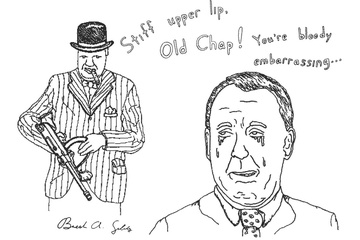If you think about it, there are really two states a Harvard student can be in: crying and not crying. Did you think we were going to say Massachusetts and New York? If so, you should start crying from shame.
As we all know, crying is easy and not crying is hard. Many things have caused us to cry in recent weeks: my academic adviser’s criticism, my FM editor’s even more unjust criticism, and that Valentine’s Day box of chocolates we saw someone else eating, just to name a few. Not many people study crying. But we do. It’s not weird. For our research, we ventured into the field to observe criers in their natural habitats. What follows are our findings on where people cry and why. We also give some advice for those not yet experienced in the art of Harvard crying.
LAMONT LIBRARY
The Lamont crier, tears dribbling onto his or her homework, wants to show the whole damned floor how much he or she cares about school. Sometimes the person lets out a soft sob and looks up to see if anyone notices. They’ll sometimes even attach themselves to one of our shoulders. How can we work with a blockmate crying like that, asking for love and support? To avoid these types, go to Widener’s Loker Reading Room, where it’s acceptable to tell people to shut up.
WITH YOUR PROFESSOR
Crying in front of your professor is kind of fun. A subpar grade always motivates this type of cry. We’ve seen teary-eyed people approach the professor after a lecture, but the prof ducks and weaves, perhaps anticipating the stream of tears about to burst forth. We recommend office hours, because the professor has to sit and stay put. It’s hard to cry for two hours, though. Some people like to bring a backpack full of chopped onions, to really get the tears flowing, but we prefer revisiting tragic personal memories. If you don’t have dark enough moments, too bad for you. If successful, you’ll watch them squirm and pretend to care. They’ll whisper sweet nothings like, “We have professional graders,” or “It’s not you, it’s me.”
ON THE BANKS OF THE CHARLES
Crying while sitting on the bench beside the Charles can be tricky. The people that go there are trying to be alone with nature. They want to appear “deep.” Maybe they’ll bellow, a guttural moan shared only between them and Mother Nature. Maybe they just want to catch a peek of their thoughtful reflection in the water. Who knows? When we jog by this type of crier, we have no idea what to do. What, are we supposed to stop and help a stranger? When we run, we’re trying to get our sweat on, not get cried on.
IN A MUSEUM
The Fogg Museum has one piece that will make you cry: this Medieval Chinese “Moon Jar.” There’s always a crowd of about 15 people there, just crying. You’d understand if you’d been there. The jar touches you to your fucking soul. Or it is your soul.
THE DINING HALL
The d-hall is a typical place to cry. You sit by yourself at the back of the d-hall. You try to keep it together but the tears start rolling down your nose and drop onto your mound of peas. You chose to eat the peas because each one used to be in a group of friends, but now is podless.
AT HOME
The crier immerses his or her head in a pillow and presses hard against the wall. When finished, the crier wipes his or her eyes and looks in the mirror to check that the reflection is happy. The person strolls out to meet the Harvard world with a smile on his or her face. We lied at the beginning. There are three states for the Harvard student: crying, not crying, and pretending not to be crying.


